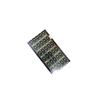Prototype PCB Assembly for Home Appliances
Name: Prototype PCB Assembly for Home Appliances
Origin: China
Certified: UL, CE, RoHS
Surface Finishing: HASL ,OSP ,ENIG, Immsersion Gold
Layer Counts: 1–20L
Base Material: FR4,High-TG FR4,CEM3,aluminum,High Frequency(Rogers,Taconic,Aron,PTFE,F4B)
Solder mask:Green, Blue, Black, White, Yellow, Red, Matt Green, Matt Black, Matt Blue
What is Prototype PCB assembly?
A wonderful technique to swiftly test and create new and inventive electronic goods is through prototype PCB assembly. It is a crucial tool for the quick creation of PCBs with a variety of components and is used for both product development and prototyping. It is also an affordable method for making items of excellent quality that satisfy client needs.
The Merits of Prototype PCB Assembly:
In order to swiftly and effectively build a proof-of-concept product before committing to full-scale manufacturing, prototype PCB assembly is a crucial step in the product development process. We go through the advantages of prototype PCB assembly in this post, including cost savings and quicker development timelines.
-
Faster Time-to-Market:
Rapid prototyping and design iteration are made possible by PCB assembly. It makes it possible for engineers and designers to swiftly test ideas, find problems, and make required adjustments. Through a quicker product development cycle, businesses may acquire a competitive edge.
-
Cost savings:
This PCB assembly helps to avoid expensive mistakes in mass production by discovering design flaws early in the development process. Before committing to full-scale manufacturing, it enables efficient troubleshooting and optimization, eventually saving time and money.
-
Customization and Flexibility:
PCB designs may be modified through prototyping to meet particular needs. To attain the best performance, engineers can test out various setups, functions, and parts. This adaptability enables increased innovation and product customization to satisfy market needs.
Applications of prototype PCB assembly:
-
Electronics prototyping:
For the development and testing of novel electronic devices, circuits, and systems, prototype PCB assembly is widely utilized in the electronics sector. Engineers can use it to make working prototypes of consumer electronics, Internet of Things (IoT) gadgets, wearable technology, robots, and other electrical items.
-
Research and development:
This PCB assembly is an essential component of research and development (R&D) operations. It makes it possible for innovators, researchers, and scientists to construct and test experimental sensors, data collecting systems, circuits, and other parts for scientific studies and technological improvements.
-
Product design and validation:
This PCB assembly helps product designers validate their ideas and designs for their products. It enables the production of tangible prototypes that can be examined for fit, appearance, and functionality. This is especially useful for businesses that manufacture industrial equipment, automobiles, and aircraft.
-
Education and learning:
This PCB assembly is used in educational facilities to educate electrical engineering, electronics, and related subjects. Students may create, put together, and test their projects and circuits while learning via doing.
-
Custom Electronics:
Businesses and people who seek customized electronic solutions use PCB assembly. It enables the development of customized electronic boards made to meet particular needs, such as those for specialized instruments, control systems, or communication devices.
-
Repair and Maintenance:
PCB assembly helps specialists troubleshoot malfunctioning equipment in the field of electronics repair and maintenance. To identify and address problems, they can make interim or replacement PCBs, assuring the efficient operation of electronic systems.






